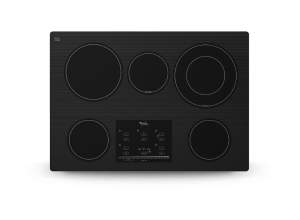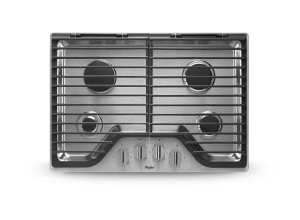A Guide To Cooktops:
What to Know When Considering a Cooktop
Because the market offers a variety of cooktop features, fuel types and configurations, it might be difficult to decide which cooktop is right for your kitchen and cooking needs.
Here are some things to consider when looking to purchase a cooktop for your kitchen.

Electric Cooktops
Elements deliver even heat, while a smooth cooktop surface makes it easy to move pots and pans where you need them.

Gas Cooktops
Burners provide the quick heat you need to get dishes simmering and the control to make sure it’s done right.

All Cooktops
Go gas or electric for the speed, precision and flexibility you need to keep dinner moving, especially on your busiest nights.
How Does a Cooktop Differ From a Rangetop?

Cooktops
Cooktops use either gas or electricity as its fuel type. They can be installed in countertops with the controls situated within the cooktop on the horizontal plane. Cooktops use either gas or electricity as its fuel type. They can be installed in countertops with the controls situated within the cooktop on the horizontal plane. As a result of less infrastructural requirements, they are typically more adept at fitting into smaller or narrower kitchen spaces than a rangetop.

Rangetops
A typical rangetop is powered by gas and is available in either a professional or commercial style. Most units come with details like heavy-duty knobs and grates and can be installed above the countertop, over the edge with controls that are positioned vertically.
Whirlpool does not offer rangetops.
Fuel Types
How to Choose One Fuel Type Over the Other
Response time can vary based on the fuel type of your cooktop. Gas and induction cooktops adapt more quickly to temperature changes. Radiant cooktops, on the other hand, may take a little longer.

Gas Cooktops
Gas cooktops - fueled by natural gas or propane - are often the choice of professional chefs due to their quick heating and precise burner control. These cooktops help you achieve that perfect sear and are ideal for simmering and wok cooking because they offer optimal control.
Shop NowElectric Cooktops
Generally, there are three options when deciding on an electric cooktop: radiant, induction or coil

Radiant Cooktops
Radiant cooktops feature an elegant design and responsive elements that can reach high temperatures. Their smooth surface makes it easier to clean compared to gas cooktops. Additionally, some models come with burners that expand and contract to match varying pot sizes and a protective coating to mitigate scratching.
Shop Now

Induction Cooktops
Induction cooktops are engineered to function differently than other cooktops. To produce heat, a coiled copper wire carries an electric current below the cooktop, creating and distributing a magnetic current throughout the cooking vessel. Furthermore, heat is directly transferred to the cooking vessel, not having to first travel through the cooking surface. This means that induction cooktops are typically able to cook more quickly and with greater efficiency than both radiant and gas cooktops. Like radiant, induction cooktops have an even and flat surface making them easier to clean than gas cooktops. Expanding and contracting burners help induction cooktops better match your pot sizes and increase the overall versatility. In addition, induction cooktops deliver precision, allowing you to effectively cook at both a high temperature and a low, consistent heat, ideal for challenging jobs like melting chocolate.
For cookware to work as intended on induction cooktops, it must be made of a magnetic metal. You can test if a pan works on an induction cooktop by holding a magnet next to it. If the magnet is attracted to the surface then the pan is suitable for an induction cooktop. Another compatibility test is to place the pan directly on the cooktop. If the display flashes or you hear a clicking sound, then remove the pan because it will not work effectively. Using the wrong pans could produce undesirable cooking results.

Coil Cooktops
Affordability makes coil cooktops a popular option but one drawback is that they can be more challenging to clean.
Whirlpool does not offer coil cooktops.
Cooktop Power & Elements
British Thermal Units (BTUs) are used to measure gas burners. It will produce a higher heat based on a higher BTU output. This is key for popular cooking methods like searing, which requires 15,000 + BTUs. A lower BTU output means a lower heat temperature like the 5000 BTUs needed to melt butter.
Watts are the unit of measurement for radiant, induction and coil burners. Higher wattage results in higher heat, ideal for searing meat (2000 watts). A lower wattage produces lower heat, helpful for sauces that require simmering (1000 watts).
Certain radiant and induction cooktops feature bridge elements for Grill and Griddles. These may have an element size range of 4” - 12” (10.2 cm to 30.5 cm) to meet the varying sizes of most pots.
Size & Burners Available

In search of a cooktop that’s the right fit for the dimensions of your kitchen? On the market are a variety of sizes to accommodate your needs.
Since kitchens don’t come in one standard size, cooktops come in a range of widths, including 30”, 36” and 48”. For smaller spaces, 15” and 24” widths are available in certain brands. Depth varies based on the model and fuel type but as a general rule, cooktops are between 20” and 28” deep.
The number of burners correlates to a cooktop’s width. 15” cooktops usually feature 1-2 burners. 24” and 30” cooktops typically have 4-5 burners and 36” cooktops can come with 5-6 burners. Cooktops with 48” width could have up to 8 burners and some also come with a Grill or Griddle. Whirlpool does not offer cooktops with a Grill.
Style and Color

Black and stainless steel are the two most common colours for built-in cooktops. Yet, there are several styles and colours available to match the look of your kitchen. Many feel that induction and electric cooktops have a modern aesthetic while gas cooktops have a more classic feel. Black tops are sometimes edged in stainless steel. The design of some cooktops include knobs whereas others have touch control.
Configurations
If you require more than a traditional cooktop, you could shop for one with a configuration specific to your needs.

Downdraft cooktops feature a built-in ventilation system inside the below cabinet. This suctions most of the smoke and odours from the cooking surface. This system allows you to forego an additional overhead ventilation hood, increasing flexibility on where you can install your cooktop. With downdraft cooktops, you can select from several venting options. Whirlpool does not offer downdraft cooktops.
External venting typically requires more open space underneath a counter for installation purposes in addition to a proper external floor or wall ventilation. Be sure to double check the installation instruction guides for cooktops provided by the manufacturer. It is also recommended to consult with your builder or cabinet supplier to review whether the materials will discolour, delaminate or have the potential to suffer any damage.
Grill & Griddle
Some cooktops have the option to increase versatility with the addition of a Grill and Griddle.

Grill
A Grill can let you grill meats, vegetables and seafood all year round inside the comfort of your kitchen.

Griddle
A Griddle provides a big cooking surface to let you grill sandwiches, pancakes, eggs, burgers, vegetables, and many more of your favourite meals for breakfast, lunch and dinner.
Installation

Typically, cooktops can be installed on a countertop against a wall. A cooktop can also be installed into a kitchen island, potentially allowing for better guest interaction and hosting. Certain models can be installed below a cooktop. You should give thought to ventilation when choosing the location of your cooktop. Wherever you choose to install your cooktop, make sure sufficient room exists to install ventilation per the requirements of your cooktop.

The majority of cooktops protrude a bit from countertops. Those that sit flush are often only available from luxury radiant and induction cooktop brands.
Follow a manufacturer’s dimension guide and template if you plan to cut your countertop to fit your new cooktop.
Need help choosing
the right cooktop?
Use our quick and easy appliance
finder tool to find the one that fits
your needs.



